Cymbals are a vital part of any drum kit. They tend to bring character into the overall drum sound, creating varying atmospheres with all their different tones.
There are so many different types of cymbal available that it can be a bit overwhelming for new drummers to understand how they all work. So, I’m going to break everything about cymbals down as clearly and precisely as I can.
After reading through these points, you’ll know what cymbals are used for different settings, and you’ll have some ideas of which cymbals to buy for yourself. Let’s jump in.
Cymbals and their Role in a Drum Kit Setup
While drums provide the low-end and punchy sounds of a drum kit, the cymbals provide different tones along with resonating effects. Cymbal sounds ring for much longer than drums, making them valuable tools in a drum setup for playing certain things.
You wouldn’t have a drum kit without cymbals, so it’s very important to have a set of cymbals that you love the sound of. Some people might tell you that cymbals are used to keep time on the drums. While that’s true, you can easily keep time with just drums as well.
I’ve always thought that it’s better to describe cymbals as the personality drivers of a drum setup. Most drums have very similar tones. Cymbals, on the other hand, vary massively in all their sounds. You could line up ten crash cymbals next to each other, and they’d all have unique tones.
Having your own set of cymbals is what gives your drum set its own unique voice. You get to choose which cymbals you want to mix together to have a full setup. That choice determines how your kit sounds compared to everyone else’s.
So, you need to know what type of cymbals you can get and how to match them together to get your personal drum set sound.
What Types of Cymbals Do Drum Sets Have?
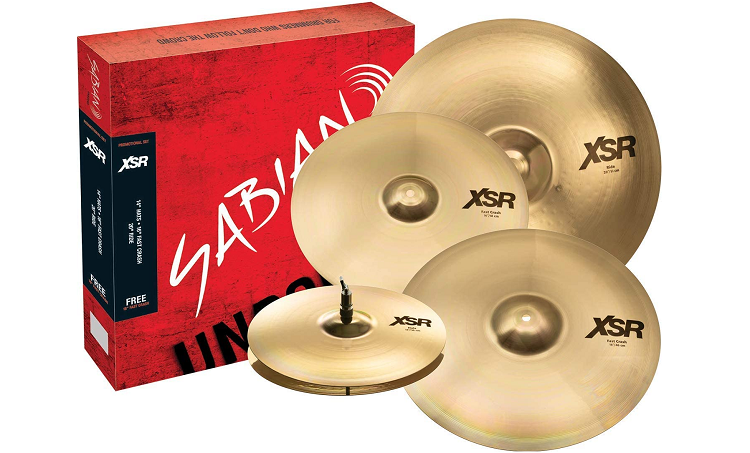
Cymbals are separated into categories. Within each category, there are hundreds of choices from different cymbal brands to choose from. Certain categories of cymbals are more important to have than others, but I’ll explain that further when we get to those specific ones.
You should accustom yourself to each type of cymbal so that you have a better understanding of how to find the best cymbals for your drum kit setup.
Here’s a list of the different types of cymbals:
- Hi-Hats
- Crash Cymbals
- Ride Cymbals
- Splash Cymbals
- China Cymbals
- Stacks
Each one has its place in a drum setup, providing unique features and sounds. Let’s have a closer look at all of them.
Hi-Hats
Hi-hats are the bread and butter of a drum setup. They’re arguably the most important part of a drum kit after the bass and snare drums. They’re also the most versatile cymbal, as you can play them in several ways to get different tones.
You always buy them in pairs and attach them to a hi-hat stand. The top and bottom hats typically have varying weights to produce a great sound when you play them together. All hi-hats range from 12” to 16”.
The reason hi-hats are so important is that you play them in most grooves. Since grooves are what you’re going to play the majority of the time on the drums, the hi-hats will be your most used cymbals in your setup.
Some drummers like to have more than one pair of hi-hats set up around their kit, but most drummers only use one. When looking to buy a pair, you should focus on finding a single good pair to start with.
Crash
Crash cymbals are what everyone thinks about when discussing general cymbals. They’re typically the cymbals that drummers play after ending off drum fills. They’re slightly large than hi-hats, ranging from 16” to 20”.
A standard drum setup will have two crash cymbals placed around the kit. However, drummers often go crazy with crash cymbals and end up placing them everywhere. It’s very common for metal drummers to have about 10 of them!
The tone of a crash cymbal is typically very loud and sharp. The amount of resonance it has depends on how big it is. The bigger a crash is, the longer it will ring.
You can keep time on a crash instead of a hi-hat if you want to have a more aggressive sound to your beats. You’ll typically see rock drummers doing this.
Ride
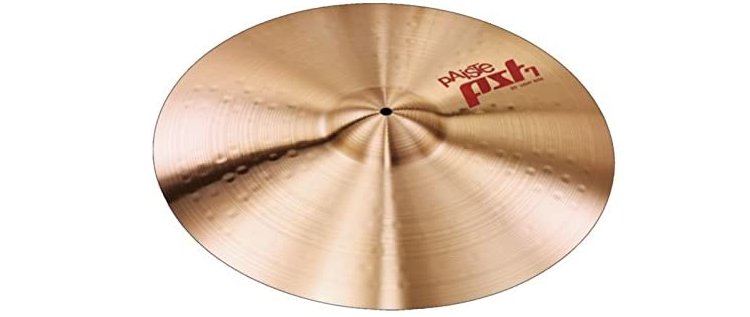
Ride cymbals are the largest cymbals in a drum setup. You’ll find rides ranging from 20” to 24”. On the surface, they act as the alternative cymbal to play other than the hi-hats when you’re keeping time.
They ring for much longer compared to the tight and short sound of hi-hats, so drummers play the ride when they need a bit more volume and intensity in certain parts of songs.
Another big aspect of the ride cymbal is the bell. While every other type of cymbal also has a bell in the middle, ride bells are much more playable as cymbal manufacturers focus on making ride bells sound great.
Many jazz drummers will say that the ride cymbal is more important than the hi-hats. You’ll need to be the judge of that when choosing which cymbals to buy.
Rides are my favorite type of cymbal. I love how diverse they can be.
Splash
Moving onto the opposite side of the spectrum, splash cymbals are the smallest cymbals you can get. They’re basically small crash cymbals, ranging from 6” to 12”. Splash cymbals produce a very high-pitched and short tone.
They’re not as popular as the previous types of cymbals I’ve mentioned. Many drummers don’t use splash cymbals as they’re not required in a drum setup.
However, the unique tone that they produce is great for utilizing within quick drum fills and nuanced styles of drumming. The main types of drummers I’ve seen using splash cymbals have been Gospel and fusion drummers.
China
Chinas have the appearance of a cymbal turned inside-out. I’ve had to explain what they are to people fairly often as their initial appearance is quite confusing. You can get china cymbals of all sizes, right from 6” to 20”.
Their main quality is trashiness. All chinas have a trashy tone with minimal sustain, making them great cymbal options to play when you need a loud and harsh sound. They’re a favorite of metal drummers as they’re one of the key cymbals to use in metal breakdowns.
Similar to splash cymbals, china cymbals aren’t everyone’s cup of tea. The harsh tone isn’t liked by everyone! Although, I’ve found that I absolutely love the sound of certain china cymbals and detest the sound of others. So, you’d benefit from doing some searching to find one that you like.
Stack
The final type of cymbal to mention is a stack. This refers to when two or more cymbals are stacked on top of each other to create a whole new sound. Stacks have become increasingly popular in modern drumming.
Most stacks produce a similar sound to a closed hi-hat, except they have a bit more resonance and ring to them.
You can buy pre-made stacks or you can create your own by stacking cymbals that you already own together. The bigger the cymbals, the more sustain the stack will have.
Some cymbals work much better in stacks than others. For example, china cymbals sound incredible when you layer a few cymbals on top of them while putting a hi-hat and crash together may end up sounding quite flat. It’s all about experimentation when it comes to stacking cymbals.
Buying a pre-made stack, on the other hand, will guarantee that you’re getting a great sound.
Cymbal Qualities
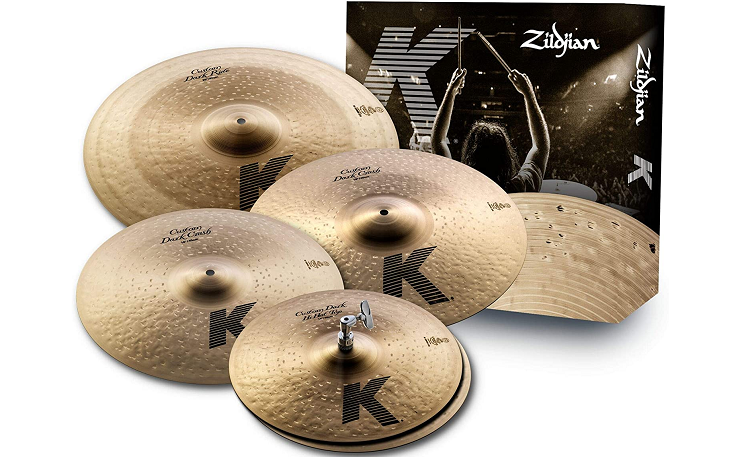
There are certain sound qualities that you need to look out for when buying cymbals. These qualities are determined by how the cymbal is made, how much it costs, and how it fits into different settings.
The big sound qualities to look out for are as follows:
- Dry
- Dark
- Bright
Some other things to look out for are what metals are used to make cymbals. Some common ones would be:
- B8 Bronze
- B10 Bronze
- B12 Bronze
- B20 Bronze
- Brass
Lastly, you’d need to take note of the appearance of the cymbal. You’ll commonly see cymbals that are:
- Lathed
- Unlathed
- Brilliant
- Traditional
- Thick
- Thin
All these things will be used to describe the cymbals, telling you exactly how they look and sound.
Buying Cymbal Packs vs Individual Cymbals
When looking to buy cymbals, you have two options. The first would be to buy each cymbal individually and create your own matching setup of cymbals for your kit. The second would be to buy a cymbal pack that includes everything you need with one purchase.
I’ve gone down both routes over the years, and I’ve learned the value of each option. One option isn’t purely better than the other as there are pros and cons to each.
Advantages of Cymbal Packs
Buying a cymbal pack is the best way of saving money when purchasing cymbals. It’s always a lot cheaper to buy a pack, especially since packs often offer a free cymbal along with the rest.
There are a few cymbal packs on the market that cost as little as $400. Getting a set of hi-hats, two crash cymbals, and a ride cymbal is a huge bargain for that amount of money.
There are also more expensive cymbal packs that have premium cymbals, but those top-quality packs are still cheaper than buying the cymbals separately.
Disadvantages of Cymbal Packs
The biggest downside of getting a cymbal pack is that you don’t get to choose the individual cymbals. That choice is already made for you, leaving you with a predetermined sound.
One of the best ways of creating a unique voice on the drums is by developing a personal cymbal sound. You do that by combining different cymbals that you like.
Most cymbal packs also come with the same line of cymbals for each cymbal type. The Meinl HCS pack has a full set of HCS cymbals, for example. While some drummers like that, many prefer to have varying lines of cymbals across their setup.
Advantages of Buying Individual Cymbals
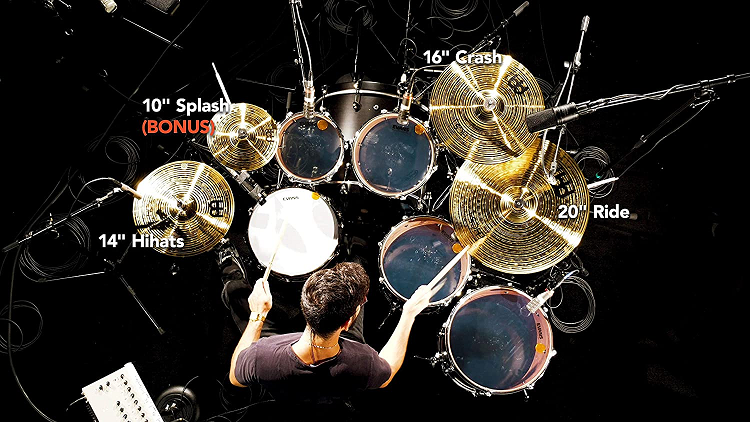
If you’re just looking to add one cymbal to your setup, buying an individual cymbal is the clear option to go with. But there are a few more benefits of buying cymbals individually, even if you need a full set.
Drummers that are more experienced often have preferences in what they like with cymbals, so the benefit of buying cymbals individually is that you get to choose the exact sound of every cymbal you have. This allows you to choose how your cymbals contrast with each other.
Buying individual cymbals also allows you to mix different lines and brands. You don’t need to stick with one brand of cymbals, opening up the possibilities to what you can mix together.
Disadvantages of Buying Individual Cymbals
Some individual cymbals will cost up to $600. That’s more expensive than most entry-level cymbal packs. It will always be more expensive to buy cymbals individually. However, that’s the only real disadvantage.
If you’re looking to save money, it’s not a good option to go with individual cymbals. You’ll find that unless you already have cymbals on your kit, buying them individually is something that only intermediate and pro drummers do.
Tips for Buying Cymbals
Before looking at some top-quality cymbal options, I’m going to give you a few tips to follow when looking to buy cymbals. These tips will help you make informed decisions that will stop you from regretting your purchase.
Firstly, make sure that you’re getting cymbals that fit into whatever style of music you play on the drums. For example, a jazz drum kit with rock cymbals will sound incredibly out-of-place in a jazz tune.
Look for certain cymbal qualities that you enjoy. If you don’t like the sound of a certain cymbal, you’re not going to end up playing it as much. I’ve had a few cymbals on my kit in the past that I didn’t love. I eventually replaced them as I realized that I hardly ever hit them when playing on my kit.
Make sure you’ve covered all your bases in terms of cymbal types. You need a pair of hi-hats, a crash, and a ride. Everything after that will come down to your personal preferences.
Lastly, make sure that you’re getting the most value for your money. Do as much research as you can to find the best deals possible.
Here’s a summary of those tips:
- Get appropriate cymbals for different musical styles
- Make sure you have cymbals with qualities that you enjoy
- Have a basic cymbal setup, then expand after that
- Look for deals with high value-for-money
My Top Recommendations for Cymbal Packs
Meinl HCS Pack
I mentioned this pack briefly earlier, but it’s well worth a full breakdown. The Meinl HCS Set is one of the best cymbal packs for beginner drummers or anyone looking for affordable cymbals.
The cymbals are made from MS63 brass alloy that gives them an articulate and clean tone. The sound is shimmering with a relatively short sustain compared to other cymbals.
They’re not the best-sounding cymbals in the world, but they’re a perfect option for new drummers who want an upgrade from the cymbals that came with their kit.
Here’s what you get in the cymbal pack:
- 14” HCS hi-hats
- 10” HCS splash
- 16” HCS crash
- 20” HCS ride
Pros
- Very affordable
- Great for beginners
- Best entry-level cymbals on the market
Cons
- Not suitable for experienced drummers
Zildjian XSR Performance Pack
The Sabian XSR Performance pack is a step up in quality from the Meinl HCS pack. These are intermediate cymbals, perfectly fit for playing gigs and recording in many settings.
They’re made from hammered B20 bronze and have a bright and shimmering tone across all the cymbals. The two crash cymbals included in the pack are fairly cutting, providing effective crashing sounds.
The hi-hats have a tight and bright chick sound, while the ride is the largest sounding cymbal of the pack. It has a looming resonance that fills a room.
This pack would be perfectly suited for anyone looking to get high-quality cymbals that are decently priced. They’re not as great as the top models from all the cymbal brands, but they’re good enough to be used in some professional settings.
The bright tone makes them great for rock and metal drumming.
Here’s what you get in the pack:
- 14” XSR hi-hats
- 16” XSR Fast crash
- 18” XSR Fast crash
- 20” XSR ride
Pros
- Intermediate cymbals
- Strong bright tones
- Good cymbals for rock and metal drumming
Cons
- Sounds may not be good enough for many pro drummers
Meinl Mike Johnston Byzance Set
The Mike Johnston Byzance set is a top-quality cymbal pack that includes some of Meinl’s best cymbals. It’s incredibly unique compared to most cymbal packs as the qualities of each cymbal are vastly different.
The ride, hi-hats, and one of the crashes are all very dry with minimal sustain. Not everyone is a fan of dry cymbals, but many pro drummers love them and use them all the time. They’re fantastic cymbals for jazz as their tones are complex, and the cymbals tend to blend well in band setups.
The 20” crash is the outlier in terms of sound quality. It’s a bit warmer than the other cymbals, and it has a huge sound when you hit it. I love how it adds a dynamic contrast to the cymbal pack. Mike Johnston calls it the “bwoosh” crash as that’s the sound it makes when you hit it.
Here’s everything you get in the pack:
- 14” Extra Dry Medium hi-hats
- 18” Extra Dry Thin crash
- 20” Extra Thin Hammered crash
- 21” Mike Johnston Signature Transition ride
Pros
- Top-quality cymbal pack
- Great for jazz
- Diverse sounds across all the cymbals
Cons
- Expensive
Zildjian K Custom Dark
The final cymbal pack that I’m going to suggest is the Zildjian K Custom Dark pack. I first played these cymbals when a church I was playing at had them on the kit. I later found out that these are some of the most popular cymbals for church drummers.
They’re another set of top-quality cymbals, giving you a professional tone from each cymbal. The tone of each cymbal is dark, meaning they have low-pitched tones that blend within mixes of instruments. That’s what makes them so good in church settings. However, they’re also fairly popular with jazz drummers.
You can lay into these cymbals and play quite hard without them ever becoming overwhelming. You can also play them very softly, and their full tone will always come out musically. They’re a great option for anyone wanting top-of-the-range cymbals.
Here’s everything included in the pack:
- 14” K Custom Dark hi-hats
- 16” K Custom Dark crash
- 18” K Custom Dark crash
- 20” K Custom Dark ride
Pros
- Beautiful dark tones
- Excellent choice for church drummers
- Diverse musical range between all the cymbals
Cons
- Expensive
My Top Picks for Individual Cymbals
Zildjian 14” A New Beats Hi-Hats
The New Beats are arguably the most famous hi-hats of all time. They’ve been used to record thousands of drum parts over the decades, covering every musical style you can think of. They’re a fantastic pair of hi-hats to choose if you’re looking for versatility.
They’re made using a secret alloy formula from Zildjian. They have a full and bright tone, easily cutting through any mix you put them in. The strong chick sound when you press your pedal down is one of my favorite aspects of these hats. I think it’s a big reason why they work so well in jazz settings as well.
Zildjian’s A Series cymbals are typically more affordable than the cymbals in their K Series. However, the New Beat hi-hats are priced a bit higher. So, you’ll be spending a fair amount of money on these. It’s well worth the investment, though. I know some drummers who have been using their New Beats hi-hats for over 20 years.
Pros
- One of the most popular pairs of hi-hats in the world
- Extremely versatile
- Very durable
Cons
- A bit pricey for a pair of hi-hats
Zildjian 18” A Custom Crash
The A Custom crash is yet another incredibly popular cymbal from Zildjian. It’s a bright cymbal that works extraordinarily well in rock, funk, and metal settings. You would have seen most drummers using one of these back in the early 2000s when hardcore music was popular.
The sound it produces is the typical crash sound that we all have in our heads when we think of a crash cymbal. It’s bright, cutting, and punchy.
I’ve suggested the 18” version of the cymbal here as I feel it’s the most versatile option. However, you can choose smaller or bigger versions of the cymbal as well.
Pros
- Bright and cutting tone
- Works well in rock, funk, and metal settings
- Well-known sound
Cons
- Not ideal for softer styles of music
Paiste PST7 Light Ride
My final cymbal suggestion is the Paiste PST7 Light ride. It’s an entry-level cymbal from Paiste. However, it has a surprisingly good sound that will fit well in some pro-level settings.
One of my favorite things about it is that it works well as a crash cymbal as well. It’s always good to have a ride cymbal that you can crash on. Most other entry-level rides don’t have this quality, ranking the PST7 a bit higher, in my opinion.
If you’re looking for an individual cymbal that won’t break your bank, this is a fantastic one to consider.
Pros
- Very affordable
- Can be crashed on
- Beautiful tone considering the low price
Cons
- Nothing much to say here
Frequently Asked Questions About Cymbals
Answer: It’s perfectly okay to buy used cymbals. In fact, the secondhand market for drums and cymbals is booming. It’s very common for drummers to buy secondhand pro cymbals to get them at affordable prices.
Pro-quality cymbals start to sound better over time, so getting them used is a clever way of getting them at their best.
Just make sure the cymbals you’re buying don’t have any cracks or dents.
Answer: The top four cymbal brands that most drummers gravitate towards are Meinl, Paiste, Sabian, and Zildjian. These brands have incredibly high-quality cymbals and have been successful in leading the sales of cymbals around the world.
However, there are smaller cymbal brands that sell cymbals that are of similar quality. They’re just not as popular. These are brands like Dream, Istanbul Agop, Soultone, and Wuhan.
Answer: Most cymbals have similar lifespans, no matter how expensive they were. The key factor in determining how long a cymbal will last depends on how it’s being played.
Playing with a good cymbal hitting technique will ensure that your cymbals last for years before they show any signs of cracking. You should be hitting across the cymbals with your sticks instead of straight at them.
Answer: When you’re starting your drumming journey, you should have a minimum of 3 cymbals. Your setup should have a pair of hi-hats, a crash, and a ride. Once you’ve become accustomed to playing with that setup, you can add as many cymbals as you like.
Some drummers stick to playing with only 3 cymbals, while others have as much as 10 in their setup. Just remember that the more cymbals you have, the more cymbal stands you’re going to need to set them up. The cost will be higher than paying for the cymbals themselves.
Conclusion
Every drummer goes on a never-ending journey of acquiring cymbals. You may be happy with the cymbals you have now, but you’ll find that you want something new and different a few months or years down the line.
Getting new cymbals is one of the great experiences of being a drummer. Make sure that you find the best cymbals for the settings that you play in. Decide whether you want to buy cymbals individually or in a pack and take it from there!
